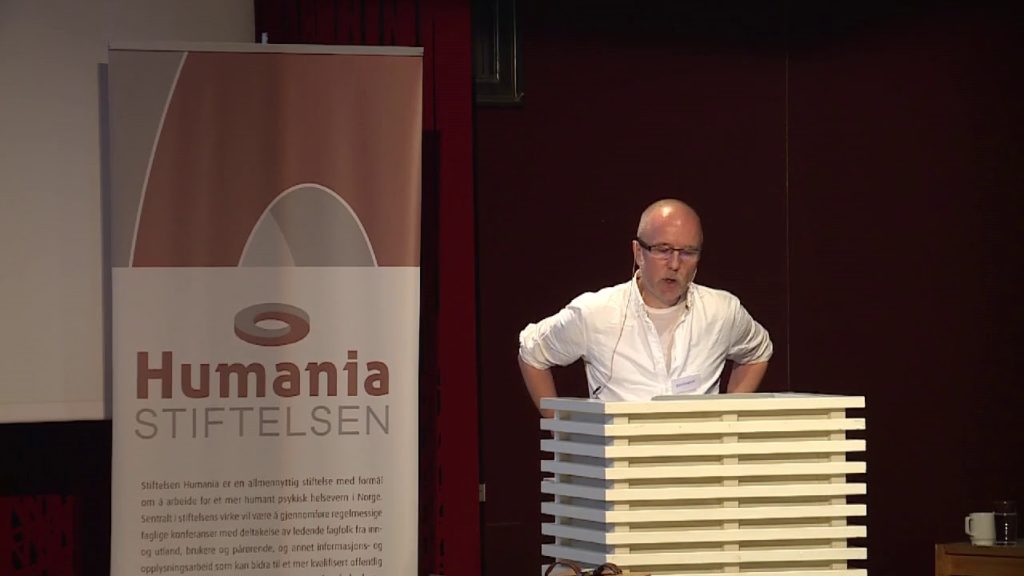A Norwegian hospital trust provides what is known as “Basal Exposure Therapy” (BET) to patients attempting to withdraw from psychotropic drugs. Researchers, led by Dr. Jan Hammer, investigated the outcome of this therapy over two years following treatment and found that those who confronted their existential anxiety had markedly better outcomes.
“At long-term follow-up after basal exposure therapy, those patients who chose to reduce their use of psychotropic drugs and gradually became drug-free showed better psychosocial functioning than those who were still using psychotropic drugs,” the authors report.

For people interested in becoming drug-free after long-term use of psychotropic drugs, there exist few viable options, particularly those backed by strong supporting evidence. Hammer and researchers review the studies they were able to find that compared drug-free psychosocial therapies to drug-based maintenance therapies for experiences related to depression, psychosis, and mood-related presentations.
One meta-analysis found that psychotherapeutic interventions combining cognitive behavioral therapy (CBT), interpersonal therapy, and mindfulness-based cognitive therapy are more promising than antidepressant drugs or regular therapy for reducing the risk of relapse of serious depression.
For patients presenting with symptoms of psychosis, results of a randomized, controlled study suggest that standard psychosocial treatment paired with cognitive therapy may work to better to reduce symptoms than standard psychosocial treatment alone. In regard to bipolar symptoms, Hammer and colleagues were unable to find any studies comparing drug-free psychosocial therapies to drug-based maintenance therapy.
The researchers in this study explore a novel form of psychosocial inpatient therapy called Basal Exposure Therapy (BET). Individuals who have histories of lengthy inpatient stays, long-term use of psychotropic drugs, use of two or more drugs simultaneously (polypharmacy), and extensive experience with coercion tend to be admitted. Such patients, considered to be “treatment resistant,” were offered BET as a way to withdraw from psychotropic drugs.
In BET, behaviors that are typically conceptualized as symptoms of mental disorders are understood to persist because people engage in avoidance behaviors. Patients tend to avoid engaging in certain behaviors, emotions, or experiences because of deep-seated fears. The researchers explain that as one’s existential fear continues to drive their avoidance, their symptoms become sustained and their fear persists.
“We assume that at the core of the patient’s mental problems lies a persistent fear of disintegrating, of being engulfed by total emptiness or stuck in eternal pain,” the authors write. “This fear is referred to as ‘existential catastrophe anxiety.’”
The BET process resembles that of other exposure therapies—the patient is gradually encouraged to test out what happens when they do not engage in avoidance behaviors. Hammer and colleagues describe that at first, the patient’s arousal and fear of existential catastrophe will increase, but as one gains the opportunity to discover that catastrophe does not occur when they are inhibited from their typical response, the response itself loses its function. This allows the patient the agency to engage in other behaviors.
“Repeated experiences of exposure violate the expectation that a catastrophe will occur,” they write. “As the patient gradually recognizes that the threat is not real, the avoidance behaviour loses its function and becomes redundant.”
Additionally, the researchers explain that psychotropic drugs and avoidance behaviors operate similarly—both are intended to suppress unwanted internal experiences—and because of this, psychotropic drugs actually impede on the BET process.
“Psychotropic drugs are therefore not only regarded as secondary to the psychotherapeutic approach, but in many cases also as contraindicated in the general treatment process,” they write.
In the study conducted by Hammer and fellow researchers, the choice to take part in BET featured creating a specific drug withdrawal program prepared by the doctor and patient jointly that focused on the patient’s own values “to promote ownership of the process.”
An earlier study indicated promise in BET, finding that patients showed improvements in symptom and function rating alongside the reduced use of psychotropic drugs. In this study, Hammer and colleagues wanted to investigate the differences in patients’ psychosocial functioning at least two years after treatment. Further, they wanted to explore whether patient engagement with BET corresponded to their outcomes: were they still using psychotropic drugs or were they drug-free?
The sample included 33 former patients of the Vestre Viken Hospital trust and other health enterprises. These patients were all women, by happenstance, who demonstrated symptoms, according to the Global Assessment of Functioning (GAF) scale, of “schizophrenia spectrum” (n=14), “affective disorder” (n=6), “neurotic disorder or stress disorder” (n=6), “emotionally unstable personality disorder” (n=5), and other “severe” diagnoses (n=2). The average age of the patients was 29.5 years.
The level to which patients decided to engage in BET was assessed with a four-point scale ranging from “no exposure” to “full exposure.” Follow-up data was collected through phone interviews with patients and/or through electronic records an average of 5.3 years (SD 3.2) post treatment.
At the time of follow-up, 16 of the former patients were drug-free. Those who were drug-free who had also utilized BET “had significantly better psychosocial functioning and showed a more positive development in terms of their ability to work and live at home unaided than those who continued to use psychotropic drugs.” Individuals who were drug-free were also less likely to have been readmitted or in continued contact with mental healthcare institutions.
Among the seven patients who were found to be fully recovered, all were completely off of psychotropic drugs. Within the drug-free group, those who engaged in BET ended up demonstrating greater psychosocial functioning and more positive developments around finding work and living independently. These trends were not observed in the group that continued to use psychotropic drugs.
Additionally, Hammer and colleagues mention evidence that patient motivation to withdraw from drugs seems to be a key factor in successful withdrawal, and that gradual withdrawal from psychotropic drugs may have led to patients benefitting more from the BET treatment. The researchers conclude:
“Our findings, that show the best results for drug-free patients with a high degree of exposure, may indicate that drug withdrawal was crucial for benefitting from the exposure.”
The researchers also highlight that a person making an individual choice to participate in the program, and having ownership and agency in the process, is crucial to successful treatment.
“Moreover, the choice to undergo exposure may in itself have been crucial, since patients in the drug-free group who had undergone a lower degree of exposure did not achieve the same degree of recovery.”
**
Read Bob Whitaker’s report on this study here: https://www.madinamerica.com/2018/03/a-tale-of-two-studies
****
Hammer, J., Heggdal, D., Lillelien, A., Lilleby, P., & Fosse, R. (2018). Drug-free after basal exposure therapy. Tidsskr Nor Laegeforen, 138(6). doi:10.4045/tidsskr.17.0811 (Link)















This is a sight for sore eyes. Convincing evidence that everybody can recover through (carefully) not taking their medication and moving to Psychotherapy.
Report comment
My own notes state “the patient says he has benefited from Psychotherapy” – whereas what I have said is that I made Recovery through Psychotherapy.
Report comment
Drugs purport to present an easy path, and any kind of quality therapeutic process requires hard work and a willingness to experience pain and discomfort. Naturally, the promise of an easy fix is appealing to a lot of people by comparison. Drug pushers know this. So do doctors and especially psychiatrists. Of course, it’s easier for the doctors, too, in the short run. Of course, only one of these approaches actually helps a person improve over time, and we know which one that is.
Report comment
Steve, On one of your other posts, you said you volunteer for a crisis line that is run the old-school way, you only call the cops with the knowledge and consent of the user. How does that work? What do you do if the caller attempts suicide while you are talking to them and won’t consent to an active rescue? Also, how can I find a crisis hotline (to volunteer for) that is run this way? Every hotline that I know of is run the standard way, calling the cops for the slightest thing, including the local hotlines in my area. Do you have any suggestions on how we can convince more hotlines to be run this way?
Report comment
I’m sure a lot of people have looked at the video, but I couldn’t see a link here so here it is:
https://www.youtube.com/watch?v=fsfdrFoEhfQ&t=1678s
Report comment